On Top of Times Square: The Penthouse Makes Its Mark on NYC Music Production
What is the official audio HQ of New York City?
Plug that question into the Internets machine, and your map just might zoom down to 723 7th Avenue. It’s between 48th and 49th Streets smack in the middle of Times Square, so to get to the ground floor door you must weave your way through a thick wandering throng — pie-eyed tourists and shrug-it-off locals alike — before you can hit the intercom and get buzzed up.
It may take a minute for those famously quirky elevators to arrive, but as you wait you can expect to be in good company. Like a beehive, the lobby fills up quickly with producers, mixers, and audio engineers, toughened veterans alongside ambitious interns. And don’t forget the artists: plugged-in paparazzi would do well to frequent this spot, where hip hop, rock and pop royalty may show up at any moment, on the hunt to mine fresh platinum. Had photographers been there at the right moment, they might have captured the attack on rapper Tupac Shakur, who was shot and robbed on that spot in 1994.
Once you’re ushered into the vertical lift, you find yourself on the rise past much more sonic history. Since Lou Gonzalez established Quad Studios in 1978 across multiple floors, the address became a literal studio stack, with different levels changing owners and names over the next four decades. Up past the 3rd floor and you pass a classic Gonzalez room just reborn, now open again as Grey Noise. Premier Studios is Sandy Schneiderman’s classic haven on floors 6 and 8, followed by Quad proper, owned and operated by Ricky Hosn since 2005, on the 10th floor.
Keep riding to the top, and you’ve arrived a level beyond the building’s 12th floor. But this is no ordinary penthouse — this is The Penthouse. It’s the latest incarnation of the building’s top floor, which was launched by Andrew Koss as Tainted Blue Studios in 2006, and then became Terminus in 2012 under the same ownership.
When Koss announced the studio’s closing in July, 2016, speculation ran rampant. Would this prized facility — who’s fabled live room had hosted scores of elite artists — cease to be a studio? Who might take a chance on extending its legacy?
Turns out the answer would arrive soon enough. Before the year was out 723 7th Avenue’s penthouse would have new ownership, and yes it was going to stay a studio. Leading the charge for the new proprietors was someone whose name may not have been that familiar with the NYC recording community, but was intimately familiar with the space: Jesse Rothman (Instagram: @JRothMusiq, @ThePenthouseNYC), an intern-turned-engineer at Tainted Blue/Terminus.
Upon hearing first whisper of the studio’s availability, Rothman became determined to own it. He assembled a consortium of investors, and today along with partners Manny Acosta and Colin Rivers is overseeing a significant transformation for the space. While the live room remains blissfully untouched and the beautiful lines plus ceiling cloud of designer Larry Swist’s 2006 control room design remain in place, it’s safe to say much has changed.
The ambiance itself has been radically realigned, simultaneously stylish and soulful, an atmospheric contrast to the analog-gear-packed audio lab in place under Koss. And while the centerpiece of Tainted Blue/Terminus’ control room were an SSL 9090J and Euphonix System 5 in succession, any notion of a console is now gone. Instead, the heft is supplied by an awe-inspiring Augspurger Duo 15 monitor system. Even though it’s guaranteed to blow your mind pure power isn’t actually the point — accurate translation is the priority, as opposed to overwhelming its listeners for pure volume’s sake.
It’s the same speaker system that powers the aforementioned Grey Noise ten floors down, The Penthouse team helped to build and establish. Married there to a rare-in-NYC Neve Genesys Black, this powerful combo looks out on the expansive live room that Gonzalez established in another era, carefully restored to its original acoustical glory, unleashing a formidable renewed addition to Manhattan recording in the process.
As 2018 draws to a close, it seems that Rothman and his colleagues are ready for the 2.0. Business is picking up as the mighty top-floor Augspurger system settles in, and word is getting around that The Penthouse is now fully available as a commercial studio. That’s just part of an evolved commerce model, one where selling studio time is one portion of the Big Picture, instead of the central nut.
Although his recent arrival as an NYC studio owner might present the appearance of a brash upstart, extended time with Rothman shows he’s anything but. After paying his dues for years spent in the engineering trenches, he’s emerged with equal parts youthful energy and hard-won wisdom, as tuned in to audio fundamentals as he is to the siren song of studio innovation.
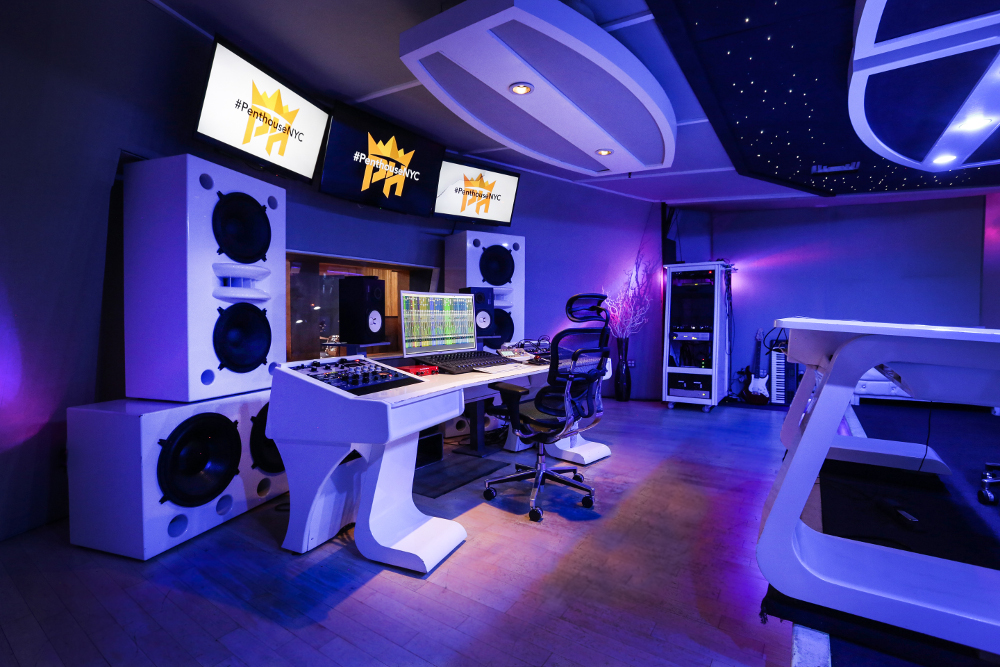
The control room at The Penthouse is a creative cocoon, augmented by Augspurger Duo 15 S218 monitors and a Zaor desk.
The last time I visited, you were just really taking ownership of the room, and it still had “that new studio smell.” What’s different at The Penthouse now than a year-and-a half ago, when you just took over this room that used to be Terminus?
Well, it’s been a ride. The transition from here to Terminus is its own movie. But since the last year that we’ve been opened, steady business and my team has really been coming into our own. We built this place DIY. I have a very small team of people who I’ve worked with for a long time.
I’m pretty satisfied with what this room is, and maybe want some additional mics for the collection — I’m a drummer, so I always want more. But in terms of the business, we’re running more smoothly. We’re a little more well-oiled. Everyone has fit into their positions well. I have hardly left since you last visited. One of the main differences with us is that we’re always here working, either for the studio or on our in house music projects.
Let’s catch people up, because I did mention Terminus. Before that, the studio was Tainted Blue, both of those under the stewardship of Andrew Koss. And prior to that, it was part of the legendary Quad Complex and a lot of Lou Gonzales’ designs and touch are still apparent here. Tell me about how you took it over, because you were once an intern here, right?
I started here working for Andrew in 2010, as an intern. That’s where I learned engineering under him and some other people and spent a couple years cutting my teeth.
When it turned into Terminus, there was new management, and we got a lot more equipment, a lot more than is in this room right now. I was very spoiled, but I got so lucky to have had the experience to learn on all that incredible outboard gear, and our mic collection.
Andrew’s definitely the reason why I’m still here. I think if I was working for anyone else, I wouldn’t have stuck around for seven years. I questioned it a few times, “What am I still doing here?” But I never questioned working for him. He allowed us a lot of freedom, and he was very eager to teach. He wanted us to just be the best engineers that we could. It was really fun working for him, so blessings to Andrew and his family. He brought Terminus up to Vermont in a new recording studio called Strawberry Fields Lane . It’s a gorgeous place.
It was 2016 I got the word — because I was on the inside — that the studio was to close and relocate up there to Vermont. So really having that early info was what allowed us to take it over. It was competitive, and we pretty much had to camp out and defend the place from all people who wanted to scoop it up.
Once we decided that we were going to move on it, things got crazy and we had to spend every waking hour here and get very creative to actually make it all work out. We took hundreds of meetings and we just barely beat everybody out to it. The infrastructure is largely what Andrew had left with the exception of this room, which we completely gutted back to original Quad days and acoustically re-treated it from the ground up in order to accommodate this massive Augspurger speaker system. So that was the transition process.
From Intern to Far Beyond
That’s a significant leap, to go from a studio intern to eventually owning the facility.
I never had intended to be a commercial studio owner in Times Square, but the opportunity presented itself. Once my business partners, Manny Acosta and Colin Rivers and I decided to do it, there was no looking back. We’ve hardly left the building since then.
It took a lot of work and a lot of energy, a lot of sleepless nights, blood, sweat and tears and sickness. We took turns sleeping every other day and alternated being sick every other week. It was like that for our first year of business largely too, so it was definitely a growth experience. It’s definitely changed me as a person. I love this place. I feel like I’ve been in this building so long, it’s become a part of me.
Everybody I know and work with and love, I’ve met here. I’m grateful to Andrew for that opportunity to allow me to come in to such a great environment and use it.
How do you think has that experience affected the way you manage the studio?
I try to reciprocate with my people and pass that on. My young guys who are coming in, we try to train them as best we can, and as long as they take care of the place and respect it, they can practice and use the rooms to work on their craft. We’ve even landed some gigs for them, some placements and licensing. There are not many mentors in this industry to help the upcoming generations so I think it’s important that these kids are growing here.
In the future, the next step that I want to take with this is a lot more on the creative side, because I’m a creative. I’m a drummer and a producer, and I’ve always been songwriting and singing since I was a kid. Now I’ve turned manager/owner out of necessity because we have a small team, but the business is good and we are on our feet so the next focus is going to shift more toward that, and I’m really excited for what we’re going to create on that end. You’ll just have wait and see.
Studio Evolution
When you got the notion that you were going to be able to go from being an intern here to the owner, I take it you had some ideas for what you wanted to retain and what you wanted to change or evolve. What were those things?
Sure, yeah. Well, there was a middle. I didn’t go [straight] from intern to owner. I worked as an engineer for a lot of years. I was fortunate to have the hindsight of the issues that I wanted to improve on. There were some holes in the sound, some bass loss in different spots and the translation wasn’t there.
I knew that we had to acoustically retreat it and that we wanted to change the speaker system in here. That was probably the biggest decision was deciding to fill the soffits in as trapping and put the speakers on the floor, because Lou Gonzalez had these places all designed the same.
You can see we haven’t really touched hardly any of it, and it’s the same with Grey Noise downstairs on the 3rd floor. We’ve maintained a lot what he did.
I knew that I had to make this room highly accurate because I wanted people to be able to mix in here and come back for more. All of the effort we put into building this space was really just this one room (Control Room A).
As I said, first we completely gutted it, which I don’t think many people would have done because it was beautiful before that, then we completely treated it. The whole rear wall is diffusion with trapping underneath the stage, and the whole front wall is pretty much absorption.
The concept is that we get one big reflection and that’s it: The sound goes past our head and hits the rear wall, comes forward again past our head and it doesn’t leave the front wall, so that’s the idea with the acoustics here.
Enter the Augspurgers
When you’re sitting at the mix position, what you’re looking at is an expanded Zaor desk, and just a little bit of outboard.
Yep, I’ve got the API 3124. We’ve got a BAE 1073. The Focusrite ISA Twin, and then we have a Tube-Tech CL 1B [opto compressor], a vintage UREI 1176 and stereo Distressors with the AVID S3 Avid control surface.
The curved screen on the video monitors seems particularly striking in here. Is that just a stylistic choice, or is there a functional/ergonomic aspect as well?
There are some touches of Larry Swist in this place as well that I wanted to retain, if you notice the curviness around the space.
This room is really designed for the way that I like to work but the good thing is that it’s all very flexible and can change easily. I like to be able to move the screen and put it wherever I want. I like the screen to be a little bit lower — I don’t want to have to look up and I don’t want to have my arms up on the table. You know what I mean? Because when you sit there for long hours, it starts to be uncomfortable. But ergonomically, it’s similar to how Andrew had it and that’s the way that I like to work. We have this huge producer desk that three people can sit and work at, so you can work from the sweet spot back there.
What’s most interesting about this control room is, it’s clearly the speakers: Were the monitors the first consideration?
Well, the monitors were the big decision. I had a lot of considerations before I chose Augspurger. I was looking at Westlakes and all kinds of other speakers. Nothing against them, but it would have been a whole lot of work to put them up in the wall soffits.
My thought was, at first, that I don’t want Augspurgers because I want to differentiate my room, and everybody has them. But once we got them, I found out there was a real reason why everybody has them. Dave Malekpour [of Augspurger and Pro Audio Design], on top of being just an awesome guy is great to work with. These speakers are incredibly musical and versatile, and revealing.
I’m an Augspurger guy for life now. I recommend them to everyone because they’re just so fantastic. You can listen to mixes that you’ve listened to for your whole life and hear things that you’ve never heard.
I think that the physical size of our system creates real separation between the midrange drivers, the tweeter, and the subs. So yeah, the room is definitely centered around those. They’re a little large for the room, which is why we had so much extensive treatment. It’s a really immersive experience.
And it’s not just for hip hop. That was my misconception in the beginning, was that those are hip hop speakers. But they’re not. I make a lot of rock music. They’re incredibly accurate. Sure, if you put an 808 on them and turn it up, it’s exciting, and the room fills up with low end. But it’s still a pretty accurate bass response. I find that my mixes translate out of this room, and I wanted the clients to have that same experience.
Which exact model of Augspurgers do you have here?
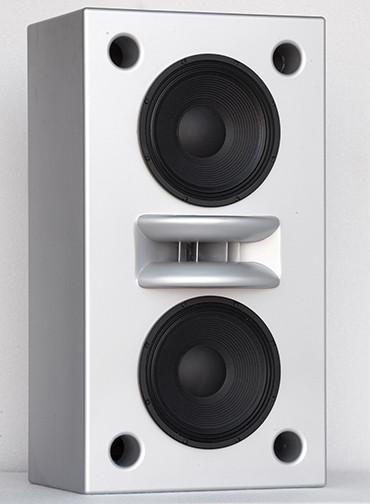
The Augspurger Duo system incorporates a pair of dual 15” drivers with a compression driver feeding a hardwood horn in a DʼAppolito array.
These are the Duo 15 S218, the vertical cabinets with dual 18-inch subwoofers per side. The Duo 15 S218 combines a pair of 215V main monitor cabinets, with a pair of DSP3 3-way amplifier modules with integrated DSP into a fully integrated three-way main monitor system.
Our system is powered by two Augspurger SXE/2500 three-way Class D networkable amplifiers (1400W, 800W & 250W) — it has active DSP providing crossover, limiting, driving alignment and system equalization and control software, rack mounted.
It’s certainly imposing in here. Tell me a little more about the experience of tuning this room, because it hasn’t been a one-shot deal, right? What have you learned about tuning a room over the course of a year?
At Terminus and Tainted Blue, we set up multiple rooms. We revamped the studio over the years, so I had some building and technical experience, but I’d never seen a pair of speakers break in, and I didn’t even know that it happened. It’s quite fascinating.
You put them in the room, and they’re these huge speakers. They’re made from really stiff parts, like the drivers, and they loosen up. So you tune them to the room, and you get it sounding good in the room how they are. But then they start to loosen over time because in my space they are pretty much running full time.
And then you make a minor tuning again from my experience, by the time we needed the third tuning the entire system broke in, specifically the subs, kind of rounded off the sound. They broke in within a week. It went from sounding kind of punchy but it was tuned that way for a reason to break them in. I wasn’t satisfied with it, but then over the course of that week, every day the sound was just dramatically different.
Since then, every band is just a lot smoother. You can turn it up louder and it doesn’t hurt. You can talk over it at loud volumes. And I find that in the new pair that I just heard the other day, of the exact same speakers, they’re still beautiful, accurate and clear, but they’re a little more ‘tight’ sounding than mine.
The process is just very interesting. Dave Malekpour is obsessed with the stuff, and he loves to teach, which is a large part of why I wanted to work with Dave because we didn’t have an unlimited budget. He cares about the product and the person that he’s selling it to. He did the first two tunings, and Dave Kotch of Criterion Acoustics did the third tuning.
Moving on from the Console
Now, one thing I notice we haven’t talked about yet is that there’s no console in here anymore. There was a big SSL here. And then I know Andrew switched out for a Euphonix System 5.
Yes, that was a big decision.
Were you sure that you did not want a console?
No, in fact, I was sure that I did.
Oh, really?
Andrew did a cooperative deal with Alto Music toward the end of Terminus, which filled out our B room. They put a little SSL AWS in there. I fell in love with that thing. And really just analog gear, because Andrew is a gearhead. We had tons of outboard analog and the digital console, which was very transparent.
I like having a console as a control surface. I’m of the opinion that, if I was going to have one, it would be an analog or a hybrid because of the quality that it adds to the sound. It tends to make everything warmer and wider, and just feel good. It makes the sound exist, takes it out of the computer, right? So I swear by that stuff.
When it came to this room, I wanted one. But I’ve completely flipped my script on it because I’ve got to tell you that if I put it in here, I think that even a year and a half in, I would have been counting on one hand people who would have really used it. I still want one for my house, but for the business, it doesn’t make any sense to me with all the computer technology that exists right now and our clients are primarily recording a vocal. A lot of producers carry their own rigs everywhere and just monitor in the studio.
You know what I mean? So this Zaor desk with this S3 is perfect. It seems to be all anybody ever needs is just really automation.
What do engineers and mixers say when they come in this room the first time?
Well, it’s the speakers. They’re definitely happy with the response of the room. They leave with what they think they’re leaving with, which was my whole intent, and our whole goal, and we achieved that.
This room is a vibe just as much as it is equipment. We built this room to create an experience, because that’s what this business is. It’s not for that S3. It’s not even for the speakers, though they help.
They want to be in an environment that inspires them. And I’ve gotten a lot of feedback about the vibe of our room, speakers and the aesthetic. People have said, “I’ve been working on this album for a year, and now I come in here, and I want to redo the whole thing and just change it all around, because I’m so inspired.” That’s the kind of stuff that makes you feel really good.
My engineer and business partner, Colin Rivers built the stars in the ceiling. He built the couches. We built this stage. All of it, we did ourselves, so we are very proud of what we’ve accomplished. And when people say how much they love the room, or they walk into the room and their jaw drops, that’s one of the best feelings, I’ve got to say.
I’m seeing an ever-more-increased awareness of the importance of lighting in studios.
The lights do make a difference. We’re always adding to the lighting, visuals and aesthetic in the space to enhance the vibe, so stay tuned for what to come.
If a guy comes in, and he says, “I want the room purple and green,” it’s no problem. If that helps you, that’s great. You’re paying, so you definitely deserve to have whatever you want, it’s supposed to be a luxurious type of experience.
More than a Studio
I know you have some other plans in the works — tell us what’s coming next.
On the commercial studio side, there’s these things that I’ve already mentioned. I’m going to add more equipment, more lighting and really ramp up the aesthetic and the client experience.
But what I’m most excited about is Phase Two, when we launch our new website to the world and show them, “Hey, there’s this beautiful commercial room that you can come rent.” But when they visit the site, they’re going to see that there’s an extension of a lot of other services that we offer.
We’ve been working as a production team — me, my business partner Manny, and Rivers, and several other people for the last decade. And most of it up here. So musically, I’m really excited about it. Manny has his debut project about to drop and we aim to take that worldwide. It’s Pop with an R&B, hip-hop, Latin twist and it’s super fun. The people love it and he’s an incredible, totally off-the-cuff freestyler. I also have an alt. rock band called CANVAS with Jerid Nowell and Daniel ‘DG Mayne’ Glavin.
There’s a lot of internal projects that we’ve been incubating for a long time now, and even all of our interns are dope producers and artists that we collaborate with. The grassroots movement we have created at Penthouse goes further than just a commercial recording space. This is our lives.
Are you launching a record label?
I don’t want to say that we are going to be a record label, because I don’t like that word. But we do incubate talent here, we curate a lot of different genres, and we have a lot of different avenues to push it all in.
Through the new website that we are launching in the spring, people will be able to access a lot of content that we create. There will be fun ways for people to engage with us and have access to all of that music, but we will also offer production and lifestyle services, aside from just selling time.
I have some of the best songwriters, engineers, producers and musicians in the city up here all the time. We do original sound design for film, television and compose music across pop, hip hop, and rock music. These are all services that I want to offer, and I want to show the world my team because what we’re truly passionate about is making music.
We’re also here to help. I’m a firm believer in energy and helping people. The music industry is ruthless, so I often go into detail with people when they are confused or potentially making a wrong decision even if it costs me a little bit of time or money. Manny and I are young. We’re always here, every single day working to push our music careers. And we’re collaborating with our people in-house, so we’re trying to help all of our people grow and find their space in the industry because there are still a lot of people in the industry who make that difficult. We just want to build something better. We want to do something that’s benevolent.
Our music is definitely going to help people, and we’re just going to continue to do what we do, because it’s working.
Embracing the Moment
We’re here at 723 Seventh Avenue, I consider this to be a pretty legendary address, because there’s so much that’s gone on here in recorded music history since the ’70s, and maybe long before that I don’t even know about. Does it carry a special responsibility for you? Do you feel additional pressure or inspiration for being in this location?
I don’t feel any pressure, but I do feel the responsibility. This place is a magnet for, not just music, but the entertainment industry and people are driven here because of the history. I’m lucky to have had these experiences and met so many of the people involved in that history and I feel honored to continue to tell it. I feel like we have become part of that history now.
I’ve been in this building since 2010 and have seen a lot, this address has definitely become a part of me. Before we had speakers up in here, in order to pay the rent we would have events and parties. I remember a kid threw up in my live room one time. My friend looked at him, and he said, “You know the Beatles have been through here, right?”
We know what we have here so we try to treat this place with respect, and not just this floor, but the whole building. Lou Gonzalez is credited with most of the history that happened here. You can look across the window [into the live room] and still see it and on the other floors as well.
So yeah. I’m grateful to be a part of the history. I love to talk about everything I’ve learned from people who were here in those days and it feels amazing to continue that legacy. You’re going to see that the next several years are going to be very dynamic here. It’s just not going to stop.
- David Weiss
Please note: When you buy products through links on this page, we may earn an affiliate commission.







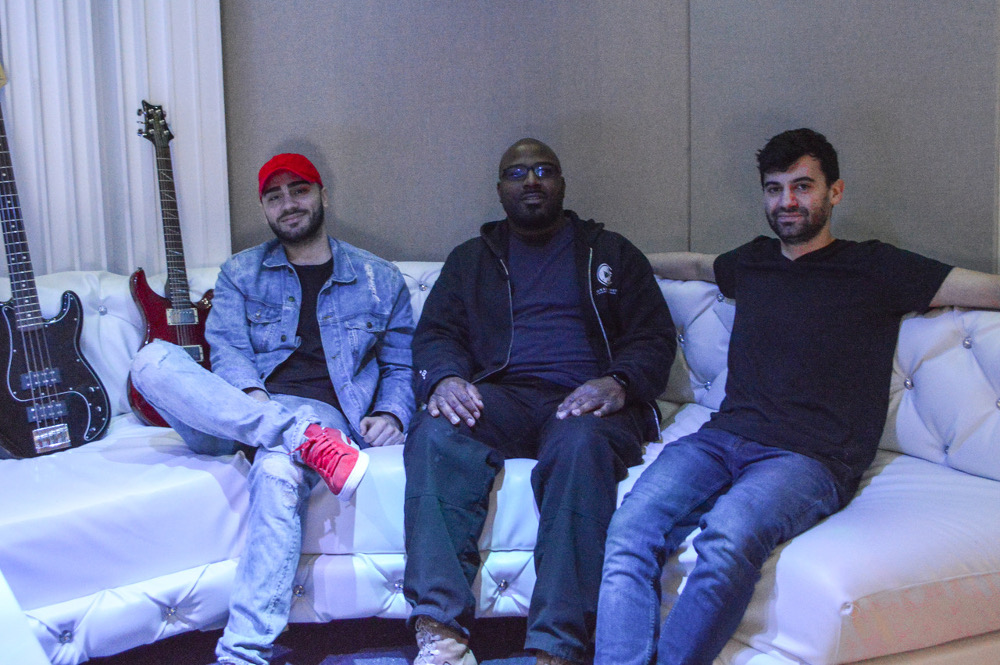
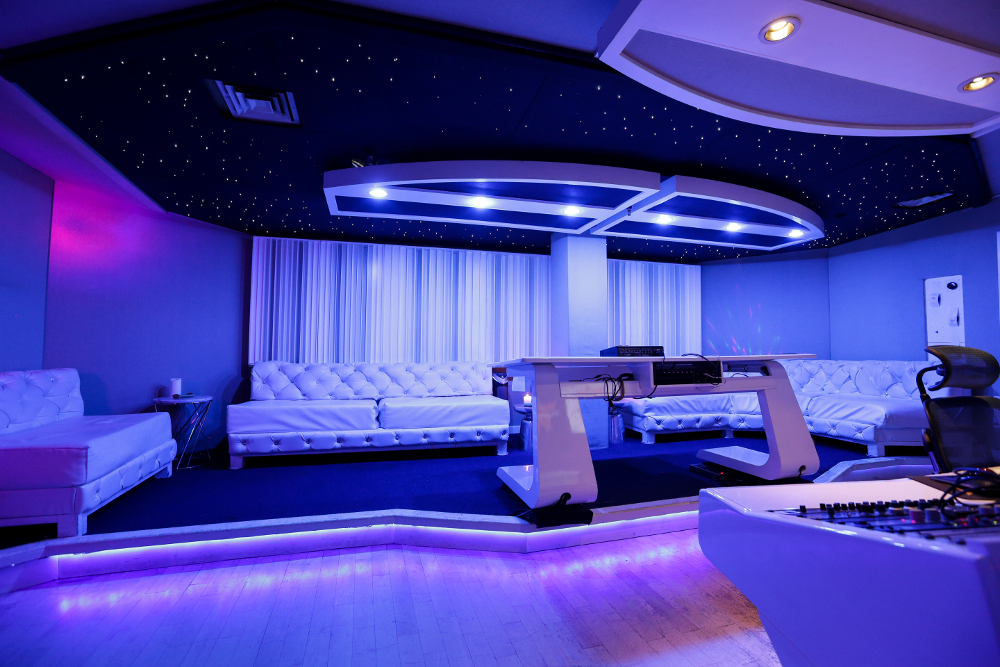
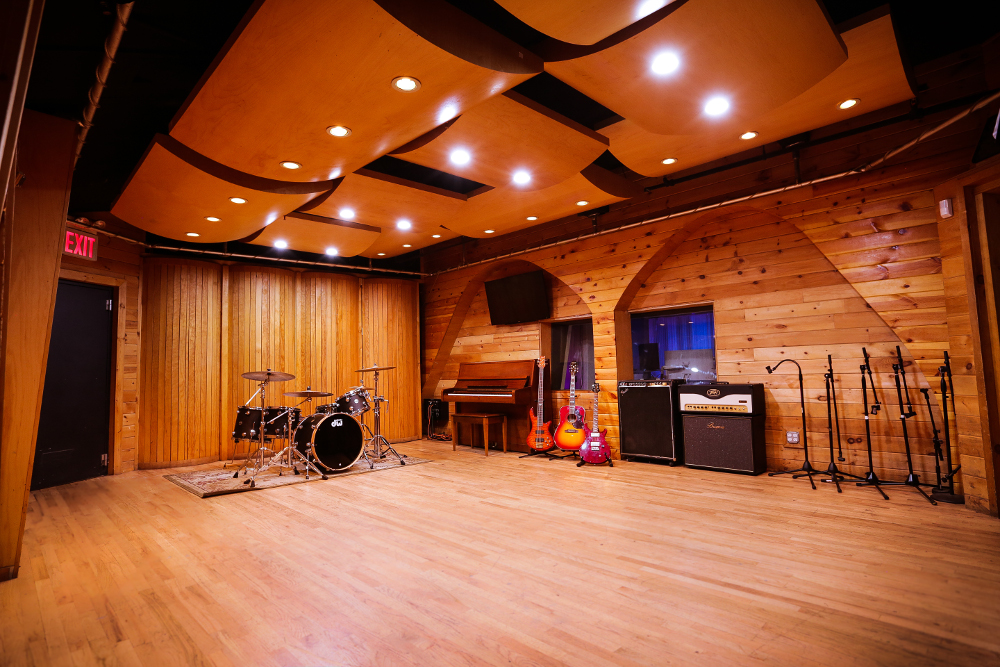
[…] http://sonicscoop.com/2019/01/14/on-top-of-times-square-the-penthouse-makes-its-mark-on-nyc-music-p… On Top of Times Square: The Penthouse Makes Its Mark on NYC Music Production […]